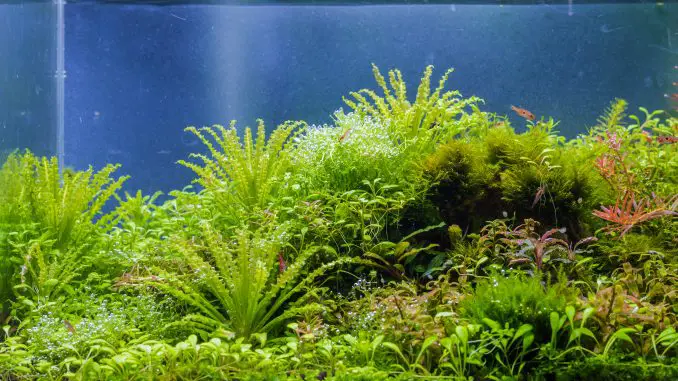
Aquatic plants come in all shapes and sizes, so there is a species to fill every niche.
Pogostemon helferi is a small freshwater species that works well when planted towards the front of your tank. It has a bold design that contrasts itself against other common species.
It can be a little demanding, but if you know how to care for it properly, anyone can keep P. helferi successfully.
This article will answer all the important questions so you can feel confident when buying P. helferi for the first time.
TABLE OF CONTENTS
Pogostemon Helferi Facts & Overview
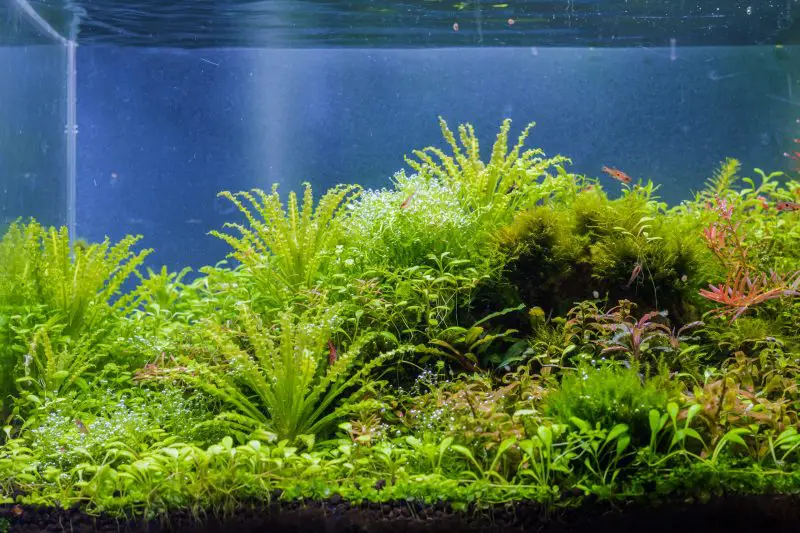
| Category | Rating |
| Care Level: | Moderate |
| Lighting: | Strong |
| Color Form: | Green |
| Origin: | Thailand |
| Height: | 2-6 inches |
| Family: | Lamiaceae |
| Minimum Tank Size: | 5 gallons |
| Tank Set-Up: | Tropical freshwater |
| Growth Rate: | Fast |
P.helferi is an attractive plant that can be difficult to care for, so aquarists are often unsure whether to add some to their aquarium.
This species is usually used in the foreground of an aquarium because its short stems don’t hide the water column behind them.
It is almost exclusive to Thailand, but it can be spotted in Burma and India too. In these tropical areas, it can survive both in and out of the water, as long as it is close to a body of water.
This versatility is very useful in an aquarium; it is an excellent candidate for a paludarium too.
While ‘P. helferi’ is the scientific name, it is known as ‘dao noi’ in Thailand, which translates to ‘little star’ in English.
It is part of the Lamiaceae family, which is more commonly referred to as the mint, deadnettle, or sage family. Most members of the family have a distinctive scent.
It is easy to find and purchase some P. helferi quite cheaply, it should only cost a few dollars. If you buy a small amount, you can propagate it yourself to quickly multiply your stock.
Always check the plant you are buying carefully. If the bright green colors are fading or the leaves are damaged, then the plant is likely in poor health.
Appearance
P.helferi is a small but attractive species that can be planted anywhere in the substrate, or attached to decorations.
It looks good on its own, but it also stands out amongst other species due to its distinctive star-like appearance.
The leaves are a vibrant green and grow outwards from a central point. Each one is long and curly with a waxy coat.
Most plants will reach a height between 2 and 6 inches, making them a great choice for the foreground. Using more intense lighting will generally reduce growth and produce smaller plants, which is often preferred for this species.
Too little light may result in your plants stretching upwards towards the light above. This will alter the shape of P. helferi from its natural star-shaped pattern.
Habitat and Tank Conditions
This plant originates in Asia and is most commonly found in Thailand. It has spread to other areas like India and Burma too.
In these areas, it can be found on the banks of rivers, lakes, and creeks.
It doesn’t need to be fully submerged in water for survival. Water levels change with the season, so during some parts of the year, this species may be covered with water, while during other parts not.
This shows the resilience of P. helferi in the wild, it is able to adapt to different environments. It prefers warm, slightly acidic conditions though.
To maximize the chance of survival at home you should recreate the natural habitat in your aquarium.
Tank Conditions
Most common substrates are suitable for P. helferi. Plant it a couple of inches into the substrate to anchor it in place. Alternatively, you can attach it to decorations using fishing wire or aquarium glue.
Place the plant somewhere with direct access to light, away from anything that might cast shade on the leaves. Consider competition for space and resources when planting many stems.
Heat the water to 74-86°F, and maintain a pH of 5.5-7.0. P. helferi can handle changes to their environment well, but try to fix the issue as soon as you can.
Strong lighting is important. Low lighting will cause the plant to grow in a different shape and could even kill it.
You may need to use fertilizer or CO2 injection but only do this if the health of the plants appears to be deteriorating.
What Size Aquarium does it need?
This is a small plant so it can fit into small aquariums. Even nano tanks are acceptable if you are prepared to trim the plant more regularly.
It will be comfortable in a 5-gallon tank.
Care
P.helferi can be quite demanding and will need a good supply of all the resources necessary for growth.
This means placing each plant in well-lit areas of the tank, and CO2 injections or fertilizer might be required if they start looking unhealthy, usually displaying a yellow coloration.
Stretching is another sign that a plant isn’t getting what it needs. This is where a plant starts growing more vertically towards the surfaces to reach more light.
In response, you should increase the intensity of your lighting or leave the light on longer each day. Aim for 8-10 hours of light a day.
Your aquarium should already be well established with a biological balance before adding P. helferi. It is also recommended to buy an adult plant with a strong root system to give it the best chance of survival.
These are the best ways to reduce the chance of melting, which is where leaves become weak and fall off because they are struggling to adapt to a new environment.
Cutting off the dying sections. Parts that regrow should be better adapted to the new conditions.
Try not to move P. helferi once you’ve planted it.
All plants need a healthy environment to survive, so you should be regularly cleaning the tank by performing partial water changes and wiping down surfaces.
Plant maintenance will be needed occasionally when it grows too large. P. helferi grows quickly, but you can trim it back down to size using scissors.
Be careful when disposing of plant cuttings because it’s easy to introduce an invasive species to your local ecosystem.
Either, bury them, use them as compost, or dissolve them in bleach to dispose of them safely.
You could always replant the cuttings in your aquarium to propagate P. helferi instead though.
Tank Mates
You can keep P. helferi in a community aquarium with a variety of tank mates.
This is a fast-growing plant so it can recover from small bits of damage caused by nibbling fish. Some fish go beyond nibbling and uproot plants (like Oscars); these species may not be suitable.
This leaves lots of other fish to choose from, like Mollies, Angelfish, Silver Sharks, Otocinclus, Yoyo Loaches, Neon Tetras, Dwarf Gourami, and Rosy Barbs.
The list goes on, but always research the fish you want to check compatibility.
Fish aren’t the only animals that can live alongside this species, invertebrates work well too.
Most snails and shrimp work well, but avoid crabs and crayfish. These are known for damaging live plants beyond recovery.
P.helferi mixes well with other plant species, so it is suitable for a paludarium. Similarly sized species make good choices, like Glossostigma elatinoides and Dwarf Baby Tears.
See related: jungle val care
Propagation
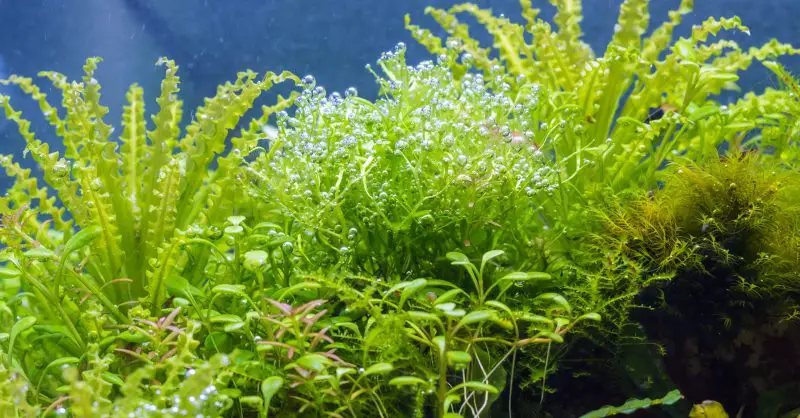
Propagation is the way in which plants reproduce or multiply. In the case of P. helferi, this is mostly done via side shoots, which each develop their own roots.
This will happen naturally on its own, but it is very easy to manipulate the process and speed up propagation.
By cutting off the side shoots, you can plant them yourself to increase the coverage of the plant on the substrate. Each cutting will develop into a new plant.
This is a good way to spread P. helferi to a new area of the tank.
Each cutting must include leaves, or else it will not be able to grow. Secure the cutting firmly in the substrate by planting it 1-1.5 inches deep.
If part of the plant is growing above the surface, small flowers may develop. These allow for an alternative method of reproduction.
They produce seeds that fall and sink to the substrate. If they fall in a suitable location, the seed can grow into an entirely new plant.
Is Pogostemon Helferi Suitable for Your Aquarium?
P.helferi can go in most tropical freshwater aquariums because its preferred water conditions are similar to many other plants and animals.
However, after reading this article you’ve probably realized that you need to be vigilant.
Keep an eye on the health of your plants, as they could need supplementing with CO2, nutrients, or extra lighting. Beginners may be unsure about how to do this and might want to try an easier plant species first.
If you feel confident about responding to the needs of your plants, P. helferi is a great option for you. It stands out as an attractive foreground species.
Do you keep Pogostemon Helferi in your aquarium? Let us know about your setup in the comments below…
See also: ludwigia repens care

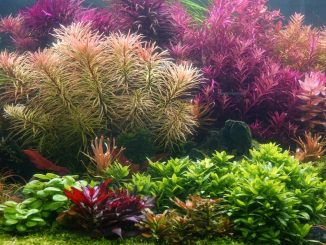
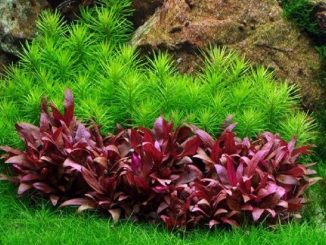
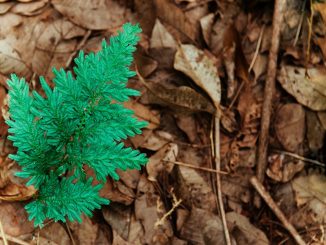
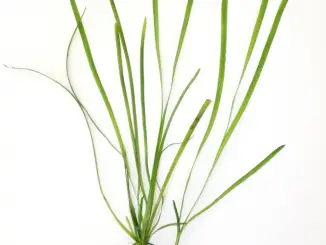
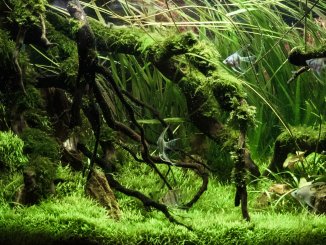
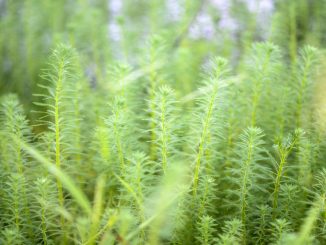

Be the first to comment